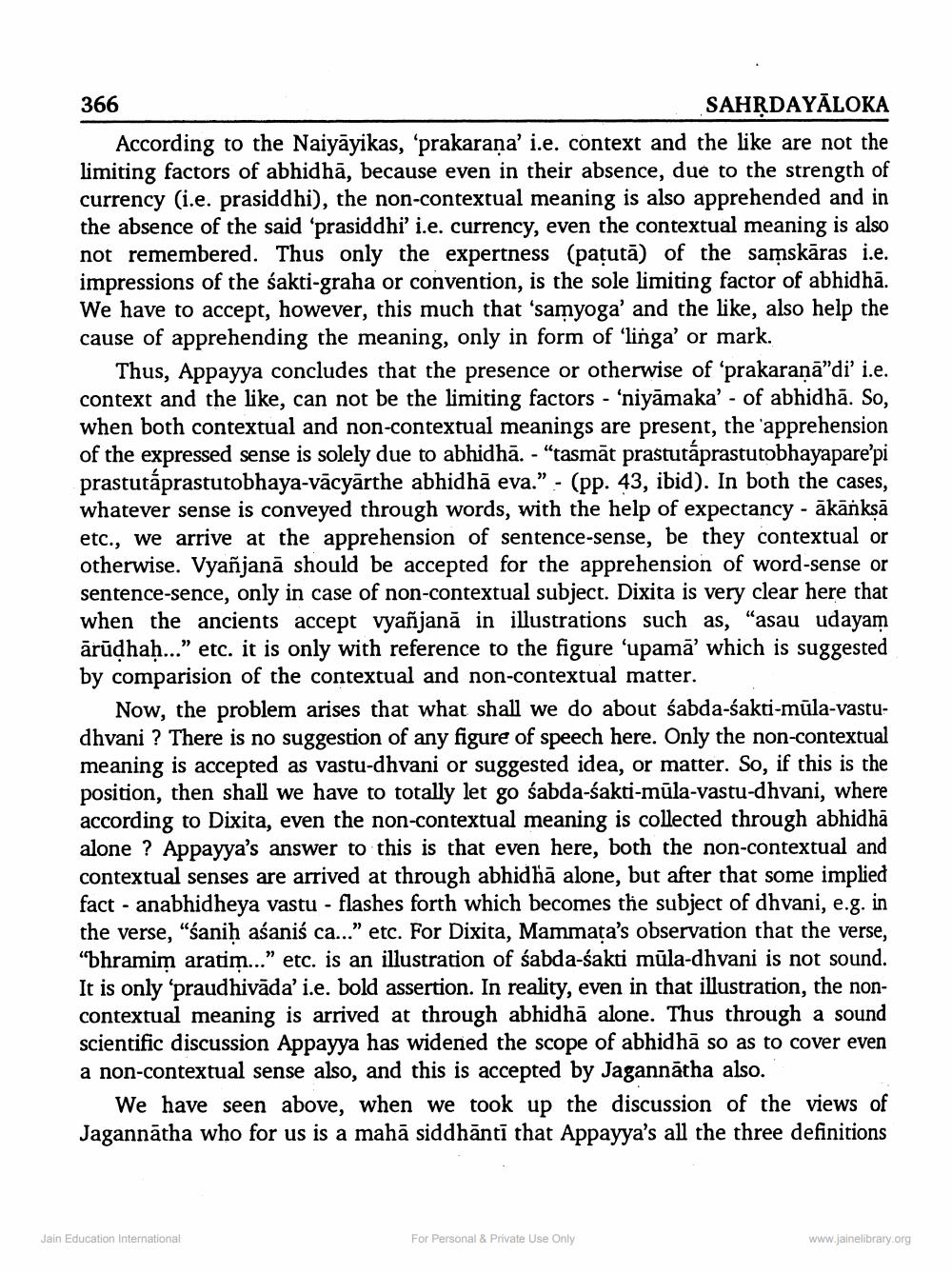________________
366
SAHRDAYĀLOKA
According to the Naiyāyikas, 'prakarana' i.e. context and the like are not the limiting factors of abhidhā, because even in their absence, due to the strength of currency (i.e. prasiddhi), the non-contextual meaning is also apprehended and in the absence of the said 'prasiddhi' i.e. currency, even the contextual meaning is also not remembered. Thus only the expertness (pațutā) of the samskāras i.e. impressions of the sakti-graha or convention, is the sole limiting factor of abhidhā. We have to accept, however, this much that 'samyoga' and the like, also help the cause of apprehending the meaning, only in form of 'linga' or mark.
Thus, Appayya concludes that the presence or otherwise of 'prakaranā"di' i.e. context and the like, can not be the limiting factors - 'niyāmaka' - of abhidhā. So, when both contextual and non-contextual meanings are present, the apprehension of the expressed sense is solely due to abhidhā. - "tasmāt prastutáprastutobhayapare’pi prastutaprastutobhaya-vācyārthe abhidhā eva." - (pp. 43, ibid). In both the cases, whatever sense is conveyed through words, with the help of expectancy - ākāńksā etc., we arrive at the apprehension of sentence-sense, be they contextual or otherwise. Vyañjanā should be accepted for the apprehension of word-sense or sentence-sence, only in case of non-contextual subject. Dixita is very clear here that when the ancients accept vyañjanā in illustrations such as, “asau udayam ārūdhaḥ..." etc. it is only with reference to the figure 'upamā' which is suggested by comparision of the contextual and non-contextual matter.
Now, the problem arises that what shall we do about sabda-sakti-mūla-vastudhvani ? There is no suggestion of any figure of speech here. Only the non-contextual meaning is accepted as vastu-dhvani or suggested idea, or matter. So, if this is the position, then shall we have to totally let go śabda-sakti-mūla-vastu-dhvani, where according to Dixita, even the non-contextual meaning is collected through abhidhā alone ? Appayya's answer to this is that even here, both the non-contextual and contextual senses are arrived at through abhidhā alone, but after that some implied fact - anabhidheya vastu - flashes forth which becomes the subject of dhvani, e.g. in the verse, “sanih aśaniś ca..." etc. For Dixita, Mammaţa's observation that the verse, "bhramim aratim..." etc. is an illustration of sabda-sakti mūla-dhvani is not sound. It is only 'praudhivada' i.e. bold assertion. In reality, even in that illustration, the noncontextual meaning is arrived at through abhidhā alone. Thus through a sound scientific discussion Appayya has widened the scope of abhidhā so as to cover even a non-contextual sense also, and this is accepted by Jagannātha also.
We have seen above, when we took up the discussion of the views of Jagannātha who for us is a mahā siddhānts that Appayya's all the three definitions
Jain Education International
For Personal & Private Use Only
www.jainelibrary.org




